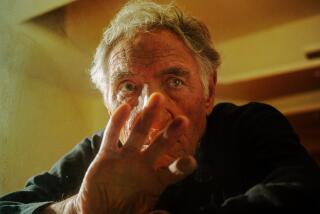David Hemmings, 62; British Actor, Director Was ‘60s Icon
- Share via
British actor David Hemmings, whose portrayal of a hip, dissolute fashion photographer in Michelangelo Antonioni’s 1966 classic “Blowup” made him an icon of the swinging 1960s, died Wednesday after being stricken on a film set in Romania. He was 62.
Paramedics were unable to revive Hemmings, who had just finished his final scenes of the day when he collapsed, his agent, Liz Nelson, told Associated Press. The cause of death was a heart attack, Associated Press reported.
Hemmings had appeared in more than 50 movies since the early 1950s, including Martin Scorsese’s recent “Gangs of New York” and Ridley Scott’s 2000 epic “Gladiator.” But he was also a prolific director, who worked largely in television during the 1980s on such popular series as “The A-Team” and “Airwolf.”
The actor first achieved international prominence starring in “Blowup” with Vanessa Redgrave and Sarah Miles. The most memorable sequence involves Hemmings in a photo session choreographed like sexual foreplay, with Hemmings clicking shots of model Verushka in a mad romp that ends with her on the floor, straddled by the camera-wielding artiste.
“Antonioni uses David Hemmings in the role very prettily -- with his Billy Budd hairdo, he’s like a pre-Raphaelite Paul McCartney,” critic Pauline Kael wrote in a 1967 essay.
Hemmings was born Nov. 18, 1941, in Surrey, England. His father, a cookie salesman and former big band pianist, gave him singing lessons, which led him by the age of 9 to join the prestigious English Opera Group as a soprano. He performed with the group until he was 14, when his voice broke on stage in Paris.
Composer Benjamin Britten wanted him to train to become a tenor, but Hemmings, who by then had made a couple of movies, decided “that wasn’t something I wanted to do.” What the young teenager did was leave home and head for Austria, where he performed magic and played the guitar in nightclubs until resuming acting.
He had appeared in close to 20 movies, most of them unmemorable, by the time Antonioni cast him in “Blowup,” a parable about a photographer who questions his frivolous lifestyle after uncovering a possible murder.
Hemmings had just finished filming “The System,” a drama with Oliver Reed about young British hoodlums, when the Italian auteur called. “He was volatile, tremendously difficult, very intense, but I loved him,” Hemmings once said of Antonioni. “It was different from any other film I’d made, because the way he directs is incredibly specific. I loved the control it put on me.”
Over the years, Hemmings regularly dismissed speculation that he modeled his character on British fashion photographer David Bailey, insisting that “an amalgamation” of photographers provided inspiration.
Most influential, Hemmings told an interviewer last year, was photographer David Hamilton, known for his soft-focus nude portraits of beautiful young women. Hamilton, Hemmings said, “explained that the difference between an amateur and a professional photographer is that a professional has absolutely no respect for the camera that he holds; he just treats it as an extension of his arm. And that’s why I just sling the camera about like that.”
Decades later, Mike Myers parodied the Hemmings character in his Austin Powers movies, in which he played a British secret agent posing as a flamboyant ‘60s-era fashion photographer.
In 1967, Hemmings formed a production company in London with John Daly called Hemdale. Hemmings left the company in 1970, more than a decade before it hit its peak with such movies as “Platoon” and the original “Terminator.”
After “Blowup,” Hemmings was in high demand as an actor, but few of his many screen appearances over the next decade were notable. He was roundly criticized for his singing as Mordred in the 1967 film version of the Lerner and Loewe musical “Camelot,” and he played opposite Jane Fonda in the campy 1968 Roger Vadim classic “Barbarella.” Hemmings also co-starred with George C. Scott in the 1977 film version of the Ernest Hemingway novel “Islands in the Stream.”
The actor began to focus on directing in the early 1970s, working chiefly on television series. He directed episodes of “Magnum, P.I.,” “Murder, She Wrote” and “In the Heat of the Night,” and made occasional guest appearances.
His film career was resuscitated three years ago, when friends who were working as assistant film directors recommended him for the role of Cassius in “Gladiator.” By then portly and raspy-voiced, he was unrecognizable to filmgoers who remembered him as the wide-eyed, boyishly handsome star of “Blowup.” But Hemmings expressed delight in the character roles he was attracting as he entered his 60s.
He earned good notices for his portrayal of an ex-boxer who joins two pub buddies in a final send-off for a beloved friend in the 2001 movie “Last Orders,” directed by Fred Schepisi. Hemmings had a small role as a 19th century aristocrat last year in Scorsese’s “Gangs of New York.”
Hemmings was married four times. One of his former wives was actress Gayle Hunnicutt. He is survived by his fourth wife, Lucy Williams; and six children.
More to Read
The biggest entertainment stories
Get our big stories about Hollywood, film, television, music, arts, culture and more right in your inbox as soon as they publish.
You may occasionally receive promotional content from the Los Angeles Times.











